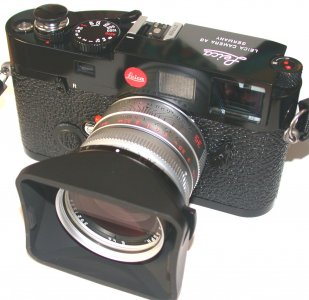dexdog
Mentor
I tried to to take the lens apart, could not unscrew the optical block from the lens mount, it is stuck tight (yes, I removed the set screw). I was able to get the name ring removed, front lens element is about 35.96mm in diameter. I was not able to get the rear triplet out, got two of the three rings unscrewed, third one would not move. The rear lens group, to the extent I was able to measure it, appears to be 27mm in diameter.When you clean it- post some pictures of the optics. That should relate it to wartime, or post-war. measure the diameters with your calipers as well.
Last edited:
I picked up this Postwar CZJ 5cm F2 Sonnar "T" in LTM recently. I believe it is a standard Contax mount lens with a custom made LTM focus mount. A simple, but effective design. The helical cannot be separated- it is held in place by the RF Cam that is permanently attached to the end of the inner helical. I had to squirt lighter fluid into the rear of the helical, work it, swab it, then work grease into it. The machining of the mount is rough. The engraving- not the quality of F-Stops engraved into the aperture ring.
In short- either made by a smaller machine shop, or "moon-lighting" at the factory. I've seen a couple of these 5cm F2 LTM lenses, and a couple with similar construction for the 5cm F1.5 post-war Sonnar.
So- take the barrel from a Contax Mount Sonnar on the right, make a focus mount for it and assume no one ever has to take it apart.
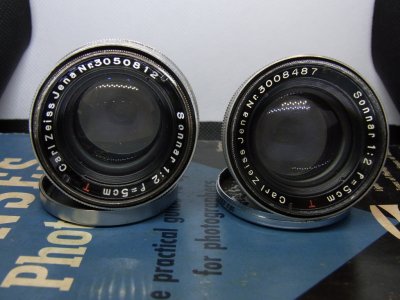
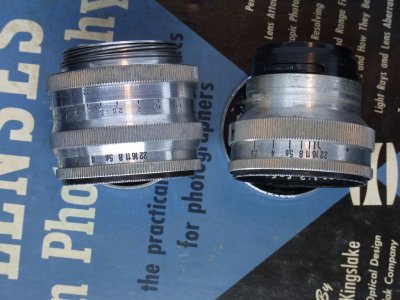
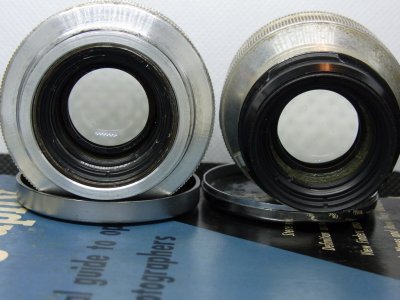
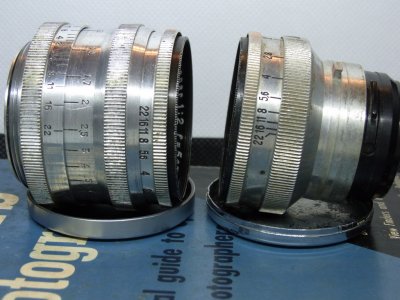
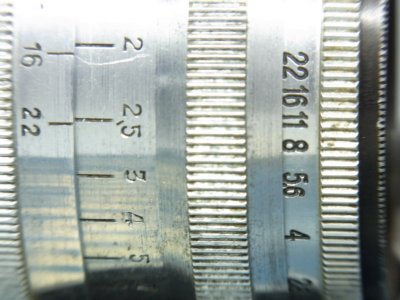

Quality of the machining on the rear of the lens- who is going to see it when mounted on a camera anyway?
Focus is perfect.

I suspect that the RF Cam is polished down to achieve a final calibration. I've had to do that on a couple of lenses before.
In short- either made by a smaller machine shop, or "moon-lighting" at the factory. I've seen a couple of these 5cm F2 LTM lenses, and a couple with similar construction for the 5cm F1.5 post-war Sonnar.
So- take the barrel from a Contax Mount Sonnar on the right, make a focus mount for it and assume no one ever has to take it apart.






Quality of the machining on the rear of the lens- who is going to see it when mounted on a camera anyway?
Focus is perfect.

I suspect that the RF Cam is polished down to achieve a final calibration. I've had to do that on a couple of lenses before.
Last edited:
Räuber
Established
Is there a document where one can see the diameters of different Sonnar formulas? The Nummernbuch II mentions 4 optical formulas that where used in production of the Sonnar 5cm f/1,5. It does not mention a different formula after WWII. Zeiss-Opton used a 5th formula for their Sonnar 50mm f/1,5. And later Carl Zeiss created a 6th formula for the C Sonnar 1,5/50. So if we go with the Nummernbuch there should be no difference in wartime and postwar Sonnar 5cm f/1,5 lenses. It is possible that different internal mountings of the lens barrel required changed lens diameters without altering the formula. But is there a documentation about all of this?I tried to to take the lens apart, could not unscrew the optical block from the lens mount, it is stuck tight (yes, I removed the set screw). I was able to get the name ring removed, front lens element is about 35.96mm in diameter. I was not able to get the rear triplet out, got two of the three rings unscrewed, third one would not move. The rear lens group, to the extent I was able to measure it, appears to be 27mm in diameter.
TenEleven
Well-known
Just a short reply because I really should be sleeping already, but while I have not come up with a good way to check the differences I am dead certain that there are differences. For example the easiest one to check is the front element. I have tried to put the good front element of a post-war Jena lens on a wartime Jena lens whose front element was trashed.
Now of course these are matched at the factory, and it's not always going to be ideal, but usually you can get away with it. You can also sub in Jupiter-3 front elements to wartime lenses - usually. However in this case I got a lens that would not render an in focus image at any distance (meaning it was pointless to try and adjust the shimming). My curiosity piqued I tried another post-war lens that I did not want to disassemble originally "for science" - same result.
So my, admittedly not very satisfactory conclusion is that they must have changed not just the diameter but the radii as well and perhaps even the glass types. But I do not have scientific proof or anything... no smoking gun
Edit: Similarly a Stuttgart lens will not help you salvage a Jena lens and vice versa.
Now of course these are matched at the factory, and it's not always going to be ideal, but usually you can get away with it. You can also sub in Jupiter-3 front elements to wartime lenses - usually. However in this case I got a lens that would not render an in focus image at any distance (meaning it was pointless to try and adjust the shimming). My curiosity piqued I tried another post-war lens that I did not want to disassemble originally "for science" - same result.
So my, admittedly not very satisfactory conclusion is that they must have changed not just the diameter but the radii as well and perhaps even the glass types. But I do not have scientific proof or anything... no smoking gun
Edit: Similarly a Stuttgart lens will not help you salvage a Jena lens and vice versa.
Last edited:
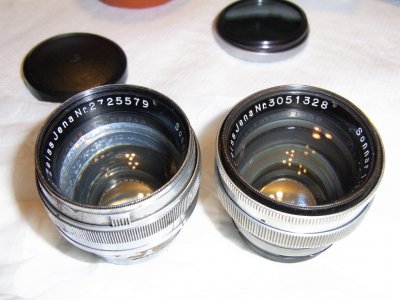
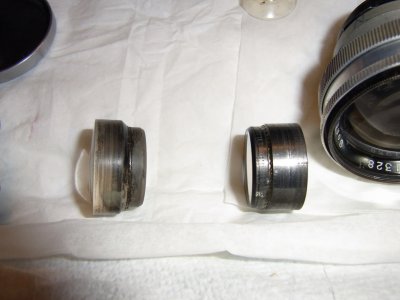
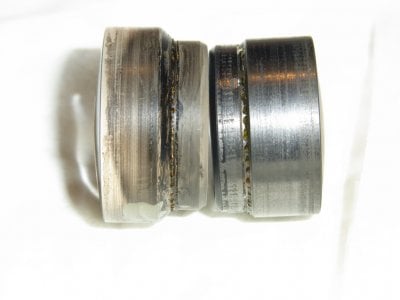
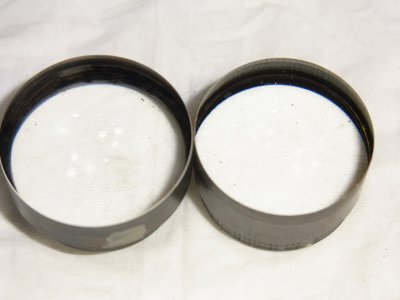
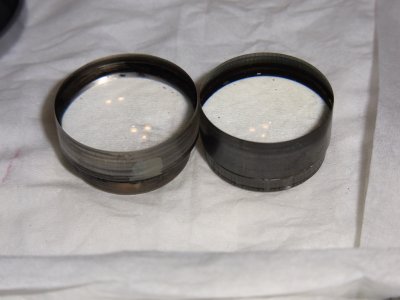
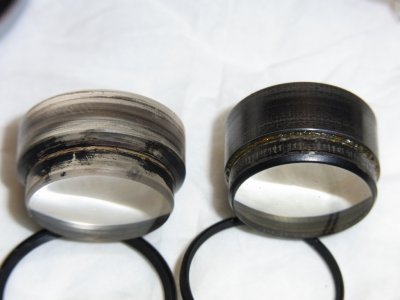
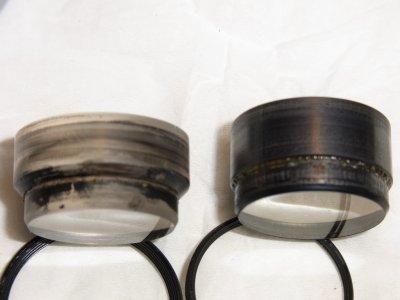
The front elements are very close in diameter, 0.02mm- close enough that I could at least fit them in each other's fixtures.
The rear triplet is different. The post-war rear triplet has a smaller diameter, and measured slightly longer- by 0.15mm or so. Hard to measure length- did not want to mar the surface on the post-war lens. I used a piece of lens cleaning paper to wrap each triplet and measure the thickest point by sliding through the digital calipers.
If I come across a wreck of a post-war Sonnar for cheap, I'll be more aggressive. As it was- had to use suction cups with lens cleaning fluid squirted to get enough force to take out the front element and rear triplet. Did not try to remove the middle group. The answer: I believe the post-war CZJ 5cm F1.5 Sonnar is a revised formula compared with the wartime lens. Kind of like "Manufacture Specifications may Change Without Notice".
dexdog
Mentor
So, the post-ww2 lens has a rear triplet that is smaller in size than the earlier lens. What are the diameters of the two?
I measured length- as that means the formula changed, diameter alone- can be truncated.
I'll hunt for a cheap one to do more testing.
I'll hunt for a cheap one to do more testing.
dexdog
Mentor
The post ww2 CZJ f1.5s are not very plentiful, may be tough finding a cheap one!I measured length- as that means the formula changed, diameter alone- can be truncated.
I'll hunt for a cheap one to do more testing.
Räuber
Established
The post ww2 CZJ f1.5s are not very plentiful, may be tough finding a cheap one!
Ebay is almost dried out at the moment. There are only haked ones or expensive ones. BUT this one has the lowest 3M serial I have seen in several years. I would have bought it already if I did not own this kind of lens already.
Your best bet might be FromJapan. A Japanese proxy site that allows orders from outside Japan for goods offered on the island: One, Two Dirt cheap compared to the only other lens shipping from Japan at the moment.
I own a small collection of post-war Sonnar 5cm f/1,5 T lenses. I noticed that the optical quality differs very much. Some are equally sharp and contrasty as wartime Sonnars. Others have low contrast and sharpness wide open. They catch up stopped down but they behave like a different lens. Interestingly I have a LTM Jupiter from 1960 that behaves just like those Sonnars. I suspected a change in the optical design but the Nummernbuch II does not show this kind of thing. Interestingly I have some later CZJ non-Contax Sonnar 1,5/50 that might be the best Sonnars CZJ has created. Don't get me wrong the difference is tiny compared to a lens like the C Sonnar 1,5/50. I would really like to solve this mystery.
@Sonnar Brian
Could you drop some measurements so that others might have a chance to join in?
Last edited:
JakobN
JakobN
Looking at the lens card in Fabrikationsbuch II and the card in Zeiss and Photography p.616 we have under "Rchg. vom" the indication of the basic formula to be used in the production, but there can be modifications and these are given in "Änderungen". There can be changes to the thickness (d) of the lenses, the distance (L) between two lens groups and to the curvature (r) of the lens surfaces. My guess is that these changes were made to correct for deviations in the different batches of glass and in that way keep the quality of the lenses as uniform as possible. So a small difference in the length of lens groups from two different productions doesn't necessarily mean a change in the basic formula.
Räuber
Established
That is a valuable information. Nevertheless the quality control did not work out.
I made a quick comparison with 8 lenses but will only include the results of 4 of them here: CZJ 5M postwar (top left), CZJ 2859k wartime LTM (top right), CZJ 3058k postwar (bottom left), CZJ 3088k postwar (bottom right)
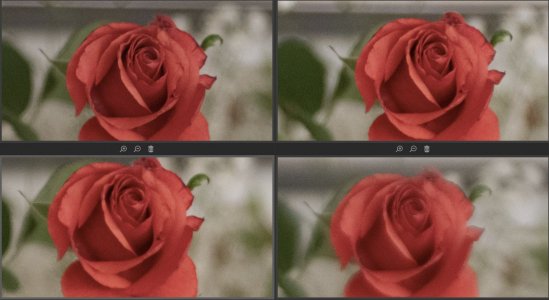
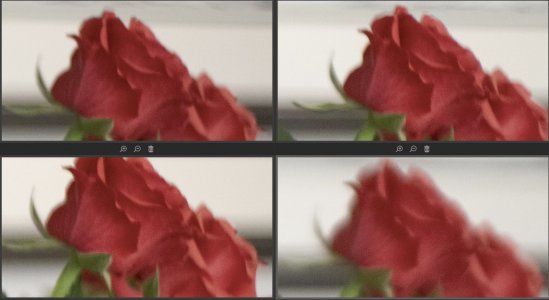
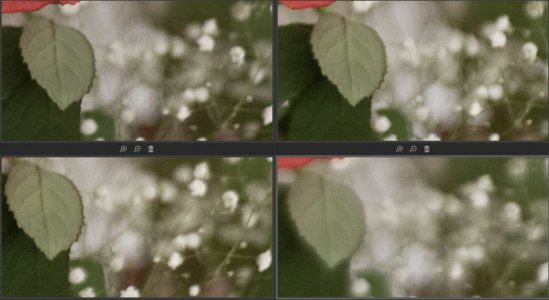
All images taken wide open at F/1,5 with a 42MP Sony A7R.
The bottom right one is not misfocused. But the sharpness of this lens made it difficult to achieve perfect focus. This is one of 2 post-war 3M Sonnar 5cm f/1,5 that I own that show this kind of sharpness. I had a 3rd one with this IQ in LTM mount (3052k) but sold it. I have another 2 post-war 3M Sonnar 5cm f/1,5 that are fine. The best of those is shown at the bottom left. For comparison there is a wartime LTM at the top right. And then there is a later CZJ Sonnar at the top left that is topping all of them.
My first thought was that they changed the glass formula or calculated a new optical formula (without Bertele). But now I guess that severe decentering or even misalignment of lens elements might causes this issues.
I made a quick comparison with 8 lenses but will only include the results of 4 of them here: CZJ 5M postwar (top left), CZJ 2859k wartime LTM (top right), CZJ 3058k postwar (bottom left), CZJ 3088k postwar (bottom right)



All images taken wide open at F/1,5 with a 42MP Sony A7R.
The bottom right one is not misfocused. But the sharpness of this lens made it difficult to achieve perfect focus. This is one of 2 post-war 3M Sonnar 5cm f/1,5 that I own that show this kind of sharpness. I had a 3rd one with this IQ in LTM mount (3052k) but sold it. I have another 2 post-war 3M Sonnar 5cm f/1,5 that are fine. The best of those is shown at the bottom left. For comparison there is a wartime LTM at the top right. And then there is a later CZJ Sonnar at the top left that is topping all of them.
My first thought was that they changed the glass formula or calculated a new optical formula (without Bertele). But now I guess that severe decentering or even misalignment of lens elements might causes this issues.
You just cost me $150..... Just bought a Digital Radius Gauge. I figure worth it to answer some of the mysteries of these lenses.Ebay is almost dried out at the moment. There are only haked ones or expensive ones. BUT this one has the lowest 3M serial I have seen in several years. I would have bought it already if I did not own this kind of lens already.
Your best bet might be FromJapan. A Japanese proxy site that allows orders from outside Japan for goods offered on the island: One, Two Dirt cheap compared to the only other lens shipping from Japan at the moment.
I own a small collection of post-war Sonnar 5cm f/1,5 T lenses. I noticed that the optical quality differs very much. Some are equally sharp and contrasty as wartime Sonnars. Others have low contrast and sharpness wide open. They catch up stopped down but they behave like a different lens. Interestingly I have a LTM Jupiter from 1960 that behaves just like those Sonnars. I suspected a change in the optical design but the Nummernbuch II does not show this kind of thing. Interestingly I have some later CZJ non-Contax Sonnar 1,5/50 that might be the best Sonnars CZJ has created. Don't get me wrong the difference is tiny compared to a lens like the C Sonnar 1,5/50. I would really like to solve this mystery.
@Sonnar Brian
Could you drop some measurements so that others might have a chance to join in?
Somewhere at work- have an ancient mechanical one, but missing the attachments.

Digital Radius Gauge Indicator R Gauge Changeable Measuring Jaw Arc Radian Gauge | eBay
Radius: 5-700mm. Radius deviation: Î R ⤠(0.02 ï¼ 2 )R.
www.ebay.com
Bill Blackwell
Leica M Shooter
My optical engineer used the term "Prescription of the lens" for the exact design, radius, curvature, index of refraction, thickness, and spacing of elements for a lens. "Formula"- was more like a block diagram.Looking at the lens card in Fabrikationsbuch II and the card in Zeiss and Photography p.616 we have under "Rchg. vom" the indication of the basic formula to be used in the production, but there can be modifications and these are given in "Änderungen". There can be changes to the thickness (d) of the lenses, the distance (L) between two lens groups and to the curvature (r) of the lens surfaces. My guess is that these changes were made to correct for deviations in the different batches of glass and in that way keep the quality of the lenses as uniform as possible. So a small difference in the length of lens groups from two different productions doesn't necessarily mean a change in the basic formula.
A "0.15mm" difference in length is bigger than what I would expect for manufacturing deviation. The shims used in these lenses go down to 0.01mm.
raid
Dad Photographer
Why is it one of a kind? It looks nice.View attachment 4833671
One-of-a-kind MP-7
Bill Blackwell
Leica M Shooter
Because AFAIK there is only one like it. It was a BP M7 with an M6 Millennium topcover (M3/2/P RW mechanism).Why is it one of a kind? ...
TenEleven
Well-known
That is a valuable information. Nevertheless the quality control did not work out.
I made a quick comparison with 8 lenses but will only include the results of 4 of them here: CZJ 5M postwar (top left), CZJ 2859k wartime LTM (top right), CZJ 3058k postwar (bottom left), CZJ 3088k postwar (bottom right)
[IMAGES TRUNCATED]
All images taken wide open at F/1,5 with a 42MP Sony A7R.
The bottom right one is not misfocused. But the sharpness of this lens made it difficult to achieve perfect focus. This is one of 2 post-war 3M Sonnar 5cm f/1,5 that I own that show this kind of sharpness. I had a 3rd one with this IQ in LTM mount (3052k) but sold it. I have another 2 post-war 3M Sonnar 5cm f/1,5 that are fine. The best of those is shown at the bottom left. For comparison there is a wartime LTM at the top right. And then there is a later CZJ Sonnar at the top left that is topping all of them.
My first thought was that they changed the glass formula or calculated a new optical formula (without Bertele). But now I guess that severe decentering or even misalignment of lens elements might causes this issues.
This meshes with my own experiences with the post-war Jena 8.5cm f2 and 5cm in f1.5, f2 experiences. The 5cm f2 is the best of the lot. The Biogon 3.5cm is okay, but somehow at least my two copies gained geometric distortion whereas the wartime and pre-war copies had almost none.
In short:
- The quality control of these lenses is very spotty, centering is often bad to very bad (you can detect this looking at slightly out-of-focus-highlights - their shape should be uniform with the brightest point in the center, but with these lenses it often is not and the bright spot "wanders about")
- The mechanical assembly of the f1.5 and the 8.5cm f2 particularly is not well thought-out and will not tolerate repeated dis- and re-assembly which adds to the pain point above. The f2 again fares better due to simpler construction
- The post-war f3.5 Tessar in Contax mount, what should be a staple lens - is (in)famous for being bad in Japan ... and the copies I had bear this out. What could go wrong on such a simple bread-and-butter staple lens, I do not know
- Their in-house-designed 3.5cm f/2.8 Biometar follows the same structure as the Opton Planar 35mm f3.5 but at f2.8 aperture. Yet the Biometar offers better contrast and color balance (read: less crushed highlights) while being sharp across the entire(!) frame at infinity at full aperture. A feat that even a good copy of the Biogon, which to be clear is a great lens, can't pull off. It is also distortion free. One of the best, if not the best 35mm for the Contax system. Shame it's scarce.
- The 25mm (not labelled in cm, oddly) Topogon is another scarce but thoroughly excellent post-war Jena lens. Zero distortion, great sharpness across the entire frame at one stop down and a very novel take on the Contax bayonet mount I wish some other lenses had implemented. It's much quicker to (un)do. This lens I bring up because the manufacture of the glasses, if you read Nikons story about trying to copy it - was a huge feat to pull off - especially in 1950.
Last edited:
dexdog
Mentor
TenEleven, interesting info in your post. i was especially interested/ pleased with your observations on the Biometar vs Planar. i have both and have always thought that the Biometar was a much better performer. i figured that maybe i just had a bad copy of the Planar.
dexdog
Mentor
Brian, I have the book that is the backdrop for this series of pics!
dexdog
Mentor

Carl Zeiss Jena Sonnar 2.8/52 | eBay
The lens is in excellent condition, fully functional. No fungus, no haze. Manufactures in Germany, D.R.P.
www.ebay.com
This one is surely a collector's item! At least the description did not say that the click-stops on aperture are crisp and that the lens was made in Japan, similar to another recent ebay item that was made in USSR. I imagine that the seller had a friend bid on it to generate interest.
Share:
-
This site uses cookies to help personalise content, tailor your experience and to keep you logged in if you register.
By continuing to use this site, you are consenting to our use of cookies.


